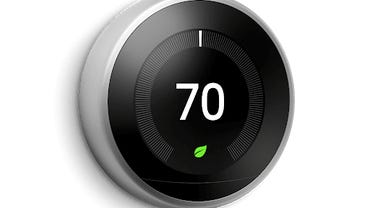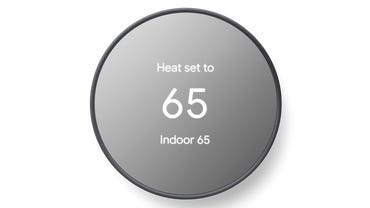
Nest Learning Thermostat vs Nest Thermostat: Which is right for you?
When looking at the Nest Learning Thermostat vs. Nest Thermostat, both are go-to smart devices for adjusting temperature around the home. After all, they’re Nests — the flagship brand for home temperature automation.
You can say that the Nest Learning Thermostat is the parent and the Nest Thermostat is the child. Before Google bought Nest, the company released the Nest Learning Thermostat (2011), which was revolutionary during its time for its sleek, understated design. The model is still alive and well today. After Google purchased Nest in 2014, it followed up with iterations, including the Nest Thermostat E and the Nest Thermostat. The Thermostat E has been dropped, leaving shoppers to decide between the Nest Learning Thermostat vs. Nest Thermostat.
Both thermostats had some changes we’ve noted in this review. The best way to differentiate these two is by pricing — the new version of the Nest Thermostat is lower in price, making it an affordable, entry-level smart thermostat for shoppers new to Nest. At the same time, the Nest Learning Thermostat is the top-of-the-line version, with a price tag to match.
Specs:
-
3.3-inch full-color display
-
Weighs 8.6Oz
-
Available in stainless steel, white, black, polished steel, copper, brass and mirror black
-
Compatible with 95% of HVAC systems as well as Amazon Alexa, Samsung SmartThings and IFTTT
-
Google Assistant voice support
-
Multi-home support
The original thermostat that started at all still looks and operates as fresh today as when it was released.
Contents [show]
Learning
The reason smart thermostats are so popular is the convenience of letting the device figure out how to keep your home comfortable without running up your electric or heating bill. The latest release of the Google Nest Learning Thermostat doubles down on its smart tech to help you control your home’s temperature. Right out of the box, it starts learning more about how to adapt by observing when you come and go and your temperature preferences. Its learning curve is fairly fast — the thermostat takes about a week to start programming itself based on the season, weather and your schedule.
Styling
Google doesn’t miss a beat, offering the thermostat in a sleek body with a metal ring. It’s available in a variety of finishes to work with all types of decor. You can choose from an analog or digital clock on the bright, crisp screen. Farsight makes sure it automatically lights up when you approach as if it’s greeting you. You’ll receive an update about the room’s current ambient conditions, weather and time. The device is multi-tasking — while it reports to you, it’s learning your habits and schedule on the fly.
Controls
If you’d like to manage your home’s temperature remotely, you can download the Nest app. The app lets you control the Nest Learning Thermostat from anywhere. It may come in handy if you have kids who forget to turn the heat down when they leave for school, or you’d like to make sure your home is cool and comfortable when you come home.
You may not need to use the app much since the thermostat will adapt and anticipate your needs. However, Nest still gives you a variety of options to control the smart thermostat. Besides the app, you can simply walk up to the thermostat, press on the display and turn the dial. You’ll see a current summary, as well as be able to access the schedule, energy history and your settings. If you prefer to remain hands-off, communicate using voice commands to set your schedule or make adjustments while you’re home.
Multi-device support
The Nest Learning Thermostat is compatible with the majority of HVAC systems. Google claims 95% compatibility. If you’re having trouble working the kinks out, you could always book installation with OnTech and let the pros set it up. It could be helpful if you’re installing multiple thermostats throughout. You can control up to 20 thermostats per home from your Nest account for up to three locations. That’s up to 60 devices, all at your fingertips.
Cost
but there’s good news. Google claims it will pay for itself in less than a couple of years based on utility savings. Plus, there may be rebates available for your area, which could also help offset the initial investment. For example, New York City residents can get $85 from Con Edison when they sign up for Rush Hour Rewards to regulate and lower energy use during peak hours. , so make sure you check for rebates in your area.
Nest Learning Thermostat Pros:
-
Learns your schedule automatically
-
Stylish, intuitive design
-
Control up to three homes containing up to 20 thermostats each
-
Monitors your HVAC system to catch possible issues early
Nest Learning Thermostat Cons:
Specs:
-
3.3-inch LCD mirrored display
-
Weighs 4.9oz
-
Available in snow, sand, fog and charcoal
-
Compatible with 85% of 24V HVAC systems
-
Google voice control and Alexa
The Nest Thermostat brings affordable efficiency for under $130, but you’ll have to give up some features.
Scheduling
What makes Nest thermostats so successful is the learning tech behind them. Unfortunately, the Nest Thermostat can be called Nest’s “lite” version and doesn’t learn the same way other Nest products do. You’ll need to enter your own schedule instead. It does have some automated functionality — if you leave the house, it will adjust the temperature to save energy.
Styling
The Google Nest Thermostat’s design isn’t as high-end as the Nest Learning’s metal trim, but the plastic body is surprisingly still clean and sturdy enough to fit into most homes. It’s probably because of the mirrored finish. In addition, the optional Trim Kit can help your wall look finished without the need to paint or patch.
Controls
One of the big drawbacks to the Nest Thermostat is the fact that it’s not compatible with the Nest app. However, you’re paying about half the price of the Nest Learning Thermostat, so maybe the trade-off isn’t so bad. Besides, you could use the Google Home app instead to control your home’s temperature from wherever you may be.
You won’t find a turn dial as you’d find on previous versions. Instead, you can make adjustments by a touch strip located on the right of the thermostat. It takes a little getting used to, but once you remember to reach to the right to swipe, you’ll like the new design.
Cost
. It’s a good entry-level option to keep your home at a comfortable temperature. If you’ve had previous Nest thermostats, you may find it a bit spare. However, anyone who is just getting started with Nest will like its intuitive feel and the low price. Love it enough, and you can upgrade to a more full-featured Nest Learning Thermostat later, once you have some heat and cooling savings under your belt.
Nest Thermostat Pros:
Nest Thermostat Cons:
-
It doesn’t work with the Nest app
-
Less compatible — works with 85% of 24V HVAC systems
-
No learning functionality
Which is the right one for you?
If you’re torn between the two, rest assured you’ll probably see energy savings with either. They both automatically adjust your home’s temperature when you leave home. However, Nest Learning is more tech-advanced, learning your schedule and preferences in about a week to automatically adapt your home’s HVAC settings.
The Nest Thermostat is the cheaper of the two but is more “manual” than the Nest Learning. You can program a schedule and make adjustments through the Google Home app, but it won’t learn and adapt as the Google Nest Learning Thermostat does. However, Google claims you can install the thermostat in 30 minutes or less, which could be a good selling point for renters.
As far as design goes, the Nest Learning Thermostat has a more high-end feel. It features metal trim, compared to Nest Thermostat’s plastic body. However, the Nest Thermostat has a sleek mirrored display and a swipe feature (instead of the traditional dial) to dress it up a bit. That being said, there’s a considerable price difference. The Nest Learning Thermostat retails for $249.99, while the Nest Thermostat costs $129.99. It’s practically half the price, but you do get about half the features. You won’t be able to integrate the lower-cost Nest Thermostat with the Nest app, and it doesn’t learn your routine. You could use the Google Home app as a replacement, but you’ll miss out on being able to control multiple devices and homes, as well as having a thermostat that starts anticipating your preferences.
Are there alternatives worth considering?
It’s hard to replace a Nest thermostat with a different brand simply because they’re so innovative and backed by Google. If you had to find an alternative for compatibility purposes or other reasons, the following smart thermostats may be worth considering.
-
. This may be the most loaded of all the thermostats. Siri and Alexa are built in, so you don’t need an Amazon Echo device. Plus, a SmartSensor worth $40 is included.
-
. Compatible with Google Assistant and Alexa, the device features humidity, temperature and proximity sensors.
-
. The Sensi is an affordable, voice-compatible thermostat that works with Google Assistant, Alexa and Siri. Budget-conscious shoppers should consider the model as an alternative to the Google Nest Thermostat.
Nest Learning Thermostat vs Nest Thermostat FAQ
How to choose between the Nest Learning Thermostat vs Nest Thermostat?
If you’d like to manage several thermostats and/or multiple homes simultaneously, the Nest Learning Thermostat is more full-featured. You can operate three homes seamlessly from the app or website. Plus, you can step back and let it learn your habits to automate your home’s comfort.
On the other hand, if you’re looking for a smart thermostat at an affordable price, the Nest Thermostat is the more affordable of the two. It doesn’t have as many bells and whistles as the Nest Learning Thermostat, but at only $129.99, you’ll have a stylish, user-friendly thermostat that can help you lower your energy bills.
What HVACs will Nest thermostats work with?
Finding a thermostat that’s compatible with your home’s AC and heating should be the first step before you buy one. Nest Learning Thermostats only work with 24V one- or two-stage systems. Fortunately, most household systems fall into those parameters. According to Google, the Nest Learning Thermostat has compatibility of 95%, and the Nest Thermostat works with 85% of HVACs.
Does the Nest Thermostat work with the Nest app?
The Nest Thermostat is the least expensive thermostat from Nest. While the $130 price point is great, it comes with some trade-offs. It’s not integrated with the Nest mobile app. However, you can remotely control your device using Google Home.






